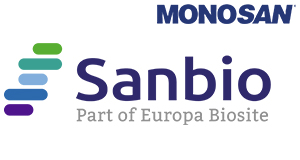Mouse anti-BAP1, clone C-4 (Monoclonal)
Mouse anti-BAP1, clone C-4 (Monoclonal)
SKU
SANMON10216
Packaging Unit
1 ml
Manufacturer
Sanbio / Monosan
Availability:
loading...
Price is loading...
Clone Number: C-4
Immunogen: Amino acids 430-729 of BAP1 of human origin
Concentration: n/a
Format: Concentrate
Storage buffer: PBS with < 0.1% sodium azide and 0.1% gelatin
Additional info: Mutations within the BRCA1 gene, localized to chromosome 17q, are believed to account for approximately 45% of families with increased incidence of both early-onset breast cancer and ovarian cancer. The BRCA1 gene is expressed in numerous tissues, including breast and ovary, and encodes a predicted protein of 1,863 amino acids. This protein contains a RING domain near the N-terminus and appears to encode a tumor suppressor. BARD1 (BRCA1-associated RING domain protein 1) and BAP1 (BRCA1-associated protein 1) have both been shown to bind to the N-terminus of BRCA1 and are potential mediators of tumor suppression. BARD1 contains an N-terminal RING domain and three tandem ankyrin repeats. The C-terminus of BARD1 contains a region with sequence homology to BRCA1, termed the BRCT domain. BAP1 is a ubiquitin hydrolase and has been shown to enhance BRCA1-mediated cell growth suppression. Pre-treatment: Heat induced epitope retrieval in 10 mM citrate buffer, pH6.0, or in 50 mM Tris buffer pH9.5, for 20 minutes is required for IHC staining on formalin-fixed, paraffin embedded tissue sections. Control tissue Pancreas, breast carcinoma, ovarian carcinoma. Staining Nuclear and cytoplasmic.
References: Hall, J.M., et al. 1990, Science 250: 1684-1689./Yoshikawa,Y., et al. 2012, Cancer Sci. 103: 868-874./Gammon, B., et al. 2013, J. Cutan. Pathol. 40: 538-542.
Immunogen: Amino acids 430-729 of BAP1 of human origin
Concentration: n/a
Format: Concentrate
Storage buffer: PBS with < 0.1% sodium azide and 0.1% gelatin
Additional info: Mutations within the BRCA1 gene, localized to chromosome 17q, are believed to account for approximately 45% of families with increased incidence of both early-onset breast cancer and ovarian cancer. The BRCA1 gene is expressed in numerous tissues, including breast and ovary, and encodes a predicted protein of 1,863 amino acids. This protein contains a RING domain near the N-terminus and appears to encode a tumor suppressor. BARD1 (BRCA1-associated RING domain protein 1) and BAP1 (BRCA1-associated protein 1) have both been shown to bind to the N-terminus of BRCA1 and are potential mediators of tumor suppression. BARD1 contains an N-terminal RING domain and three tandem ankyrin repeats. The C-terminus of BARD1 contains a region with sequence homology to BRCA1, termed the BRCT domain. BAP1 is a ubiquitin hydrolase and has been shown to enhance BRCA1-mediated cell growth suppression. Pre-treatment: Heat induced epitope retrieval in 10 mM citrate buffer, pH6.0, or in 50 mM Tris buffer pH9.5, for 20 minutes is required for IHC staining on formalin-fixed, paraffin embedded tissue sections. Control tissue Pancreas, breast carcinoma, ovarian carcinoma. Staining Nuclear and cytoplasmic.
References: Hall, J.M., et al. 1990, Science 250: 1684-1689./Yoshikawa,Y., et al. 2012, Cancer Sci. 103: 868-874./Gammon, B., et al. 2013, J. Cutan. Pathol. 40: 538-542.
| SKU | SANMON10216 |
|---|---|
| Manufacturer | Sanbio / Monosan |
| Manufacturer SKU | MON10216 |
| Package Unit | 1 ml |
| Quantity Unit | STK |
| Reactivity | Human |
| Clonality | Monoclonal |
| Application | Immunohistochemistry (paraffin) |
| Isotype | IgG1 |
| Host | Mouse |
| Conjugate | Unconjugated |
| Product information (PDF) | Download |
| MSDS (PDF) |
|

 Deutsch
Deutsch







